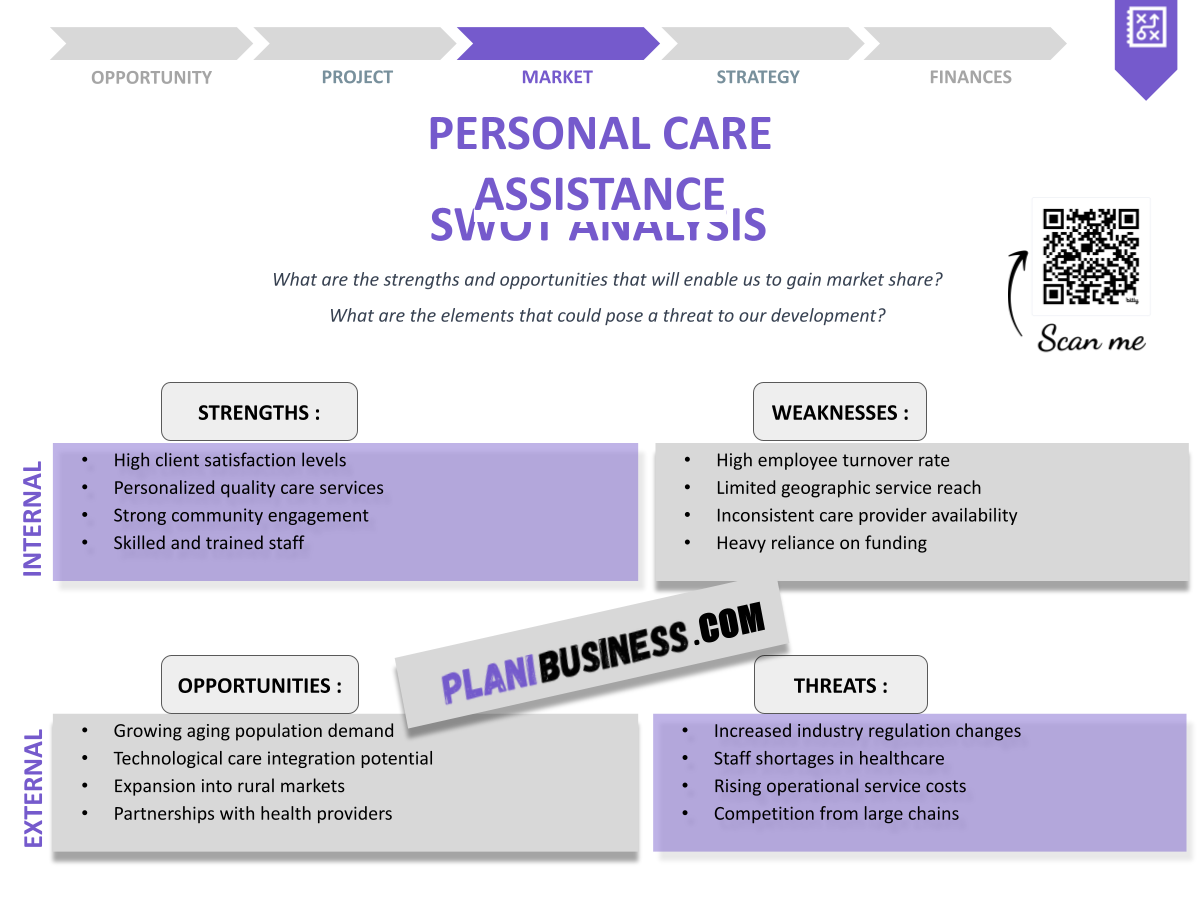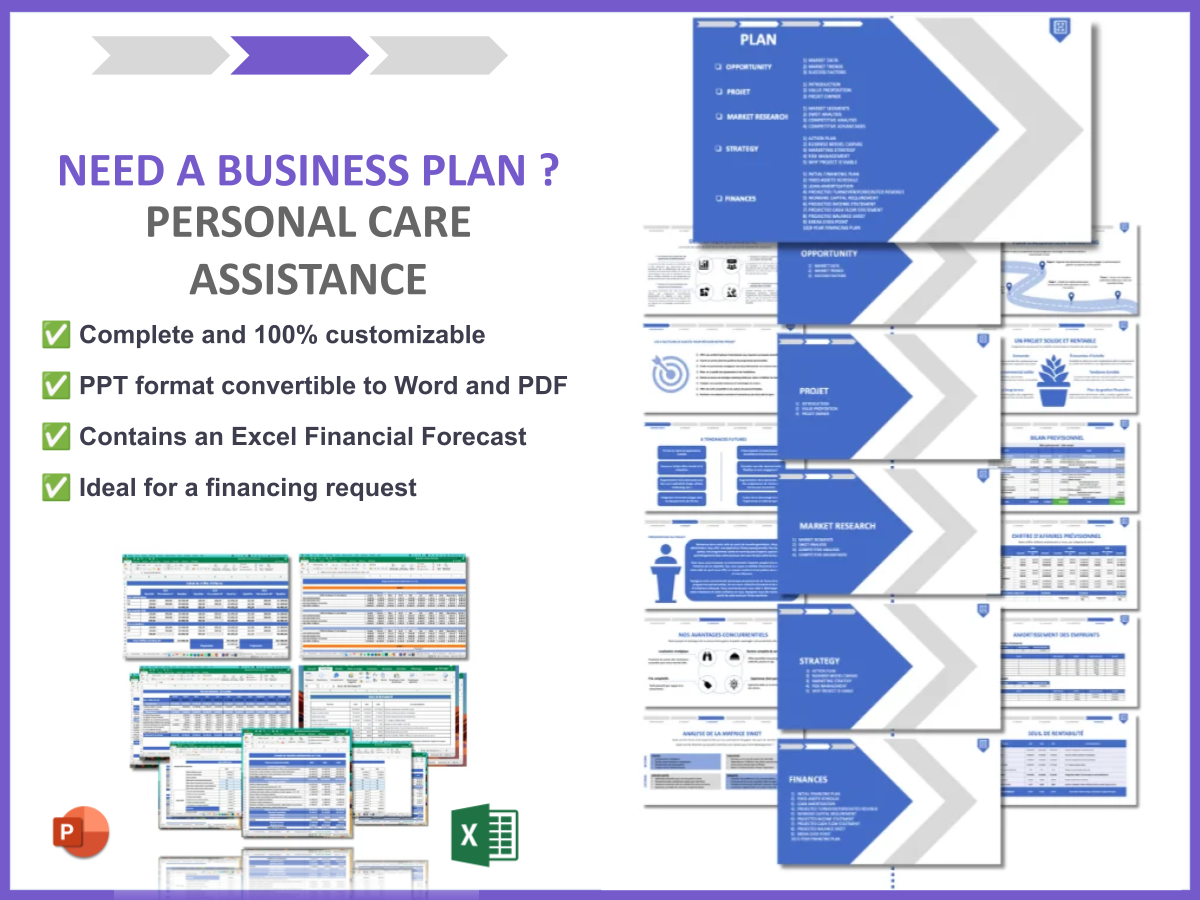Why Should You Have a SWOT Analysis for Personal Care Assistance?
Did you know that nearly 70% of businesses fail because they don’t have a clear understanding of their strengths and weaknesses? This is particularly true in the personal care assistance sector, where competition is fierce and client needs are ever-evolving. A SWOT analysis can provide clarity and direction for your services.
A SWOT analysis is a strategic planning tool that helps organizations identify their Strengths, Weaknesses, Opportunities, and Threats. It’s essential for making informed decisions in personal care assistance.
- Understanding the importance of SWOT analysis.
- Step-by-step guide to writing a SWOT analysis.
- Real-world examples of effective SWOT analyses.
- Key strengths to leverage in personal care.
- Common weaknesses to address.
- Opportunities in the personal care market.
- Threats to be aware of in the industry.
- How to implement findings from your SWOT analysis.
- The role of continuous evaluation.
- Final thoughts on using SWOT for growth.
How Do You Write a SWOT Analysis for Personal Care Assistance?
Crafting a SWOT analysis involves careful thought and collaboration. Begin by gathering your team to discuss the internal and external factors affecting your personal care services.
Strengths
Identify the unique strengths of your personal care services, such as experienced staff or specialized programs. A strong team can significantly enhance service delivery and client satisfaction.
Discuss the benefits of personalized care and how it sets you apart from competitors. Tailored approaches often lead to higher client retention rates.
Highlight any certifications or accreditations that enhance your credibility in the personal care assistance field. These can be key selling points for attracting new clients.
Mention technological tools that improve service delivery. Utilizing the latest tech can streamline operations and enhance client experiences.
Weaknesses
Acknowledge common weaknesses, like staffing shortages or high turnover rates. These issues can impact service quality and client trust.
Discuss the limitations of your current service offerings. Are there gaps in your services that could be addressed to better meet client needs?
Identify areas where customer feedback indicates dissatisfaction. Listening to clients is crucial for making necessary improvements.
Explore the impact of inadequate marketing strategies. Without effective outreach, even the best services can go unnoticed in a competitive market.
Opportunities
Look into emerging trends in personal care, such as telehealth. The rise of digital services presents new avenues for care delivery.
Identify potential partnerships with healthcare providers. Collaborations can expand your service offerings and client base.
Discuss demographic shifts that may increase demand for personal care assistance services. Understanding these trends can help you stay ahead.
Explore funding opportunities or grants available for personal care agencies. Financial support can significantly enhance your capabilities and reach.
Threats
Discuss competition from larger organizations and how it impacts your market share. Knowing your competition is vital for strategic planning.
Address regulatory changes that could affect operations. Staying informed about policy shifts is crucial for compliance and adaptation.
Identify economic factors that may pose risks. Economic downturns can affect client budgets and demand for services.
Consider the impact of public perception on personal care services. Negative reviews can harm reputation and client trust, making reputation management essential.
SWOT Example N°1 for Personal Care Assistance
Let’s dive into a practical example of a SWOT analysis in action within a personal care agency.
| SWOT | Analysis |
|---|---|
| Strengths | Highly trained staff, personalized care plans |
| Weaknesses | Limited marketing reach, high turnover |
| Opportunities | Growing elderly population, telehealth services |
| Threats | Competition from larger companies, regulatory changes |
- Personalized care leads to higher satisfaction.
- Employee training enhances service quality.
- Marketing outreach can increase client base.
- Adapting to regulatory changes is crucial.
This example shows that while the agency has significant strengths, addressing its weaknesses through better marketing and employee retention strategies could lead to improved performance and client satisfaction.
SWOT Example N°2 for Personal Care Assistance
Here’s another example that illustrates how a personal care agency can benefit from a SWOT analysis.
| SWOT | Analysis |
|---|---|
| Strengths | Strong community ties, diverse service offerings |
| Weaknesses | Limited technology use, inconsistent service delivery |
| Opportunities | Increased demand for in-home care, potential grants |
| Threats | Economic downturns, negative reviews impacting reputation |
- Community involvement strengthens trust.
- Diverse services attract a broader client base.
- Embracing technology can streamline operations.
- Monitoring reviews is essential for reputation management.
This example emphasizes the importance of community ties and the need for technology integration to improve service delivery and client satisfaction.
SWOT Example N°3 for Personal Care Assistance
Here’s a different perspective on how a personal care agency can use SWOT analysis effectively.
| SWOT | Analysis |
|---|---|
| Strengths | Experienced leadership, high client retention |
| Weaknesses | Limited geographical reach, lack of online presence |
| Opportunities | Partnerships with local hospitals, online marketing |
| Threats | Rising operational costs, changes in client needs |
- Experienced leadership is a competitive advantage.
- High client retention indicates quality service.
- Online marketing can attract new clients.
- Understanding changing client needs is critical.
This example illustrates how experienced leadership can foster a strong organizational culture while highlighting the importance of adapting to market changes.
SWOT Example N°4 for Personal Care Assistance
Let’s take a look at yet another effective SWOT analysis example.
| SWOT | Analysis |
|---|---|
| Strengths | Comprehensive training programs, positive client feedback |
| Weaknesses | High operational costs, limited service areas |
| Opportunities | Aging population, potential for expansion |
| Threats | Increased competition, changes in healthcare policies |
- Training programs enhance service quality.
- Positive feedback builds reputation.
- Expansion can tap into new markets.
- Competition requires innovative strategies.
This analysis shows that while high operational costs can be a concern, the potential for expansion into new markets offers a promising opportunity.
SWOT Example N°5 for Personal Care Assistance
Here’s another example to consider.
| SWOT | Analysis |
|---|---|
| Strengths | Strong referral network, tailored care options |
| Weaknesses | Inconsistent service quality, limited staff training |
| Opportunities | Collaboration with healthcare providers, technology adoption |
| Threats | Economic fluctuations, client retention challenges |
- A strong referral network can drive new business.
- Tailored care options enhance client satisfaction.
- Collaboration can expand service offerings.
- Addressing service quality is crucial for retention.
This example highlights the value of referral networks and the need for consistent service quality to maintain client trust and satisfaction.
SWOT Example N°6 for Personal Care Assistance
Let’s explore another effective SWOT analysis.
| SWOT | Analysis |
|---|---|
| Strengths | Established brand, strong client relationships |
| Weaknesses | Lack of modern technology, limited service diversity |
| Opportunities | Increased funding for elder care, innovative service models |
| Threats | New entrants in the market, changing regulations |
- An established brand fosters trust.
- Strong client relationships lead to repeat business.
- Funding opportunities can enhance service offerings.
- New entrants require strategic differentiation.
This analysis underscores the importance of an established brand and the necessity of adapting to new market entrants and regulations.
SWOT Example N°7 for Personal Care Assistance
Here’s another example to consider.
| SWOT | Analysis |
|---|---|
| Strengths | Diverse skill set among staff, personalized approach |
| Weaknesses | Limited visibility in the market, high staff turnover |
| Opportunities | Growing demand for specialized services, partnerships |
| Threats | Economic downturns affecting client budgets, competition |
- A diverse skill set enhances service delivery.
- Personalized approaches improve client satisfaction.
- Partnerships can expand service reach.
- Economic downturns require flexible pricing.
This example highlights the advantages of a diverse skill set while addressing the challenges posed by market visibility and economic factors.
SWOT Example N°8 for Personal Care Assistance
Here’s another perspective on SWOT analysis.
| SWOT | Analysis |
|---|---|
| Strengths | High-quality training, community involvement |
| Weaknesses | Limited advertising budget, aging technology |
| Opportunities | Community events for outreach, digital marketing |
| Threats | Local competition, changing client expectations |
- High-quality training leads to better service.
- Community involvement builds trust.
- Digital marketing can enhance visibility.
- Adapting to client expectations is vital.
This analysis shows that while limited advertising budgets can be a challenge, community engagement and digital marketing present valuable opportunities.
SWOT Example N°9 for Personal Care Assistance
Here’s yet another example for your consideration.
| SWOT | Analysis |
|---|---|
| Strengths | Strong leadership, established client base |
| Weaknesses | Inconsistent service levels, lack of marketing strategy |
| Opportunities | Expanding service offerings, online presence |
| Threats | Regulatory changes, economic pressures |
- Strong leadership fosters a positive work environment.
- An established client base ensures stability.
- Expanding services can attract new clients.
- Adapting to regulatory changes is essential.
This example emphasizes the role of strong leadership and the need for effective marketing strategies to maintain a competitive edge.
SWOT Example N°10 for Personal Care Assistance
Finally, let’s look at one last example.
| SWOT | Analysis |
|---|---|
| Strengths | Positive client testimonials, comprehensive care plans |
| Weaknesses | Limited training resources, high operational costs |
| Opportunities | New technology adoption, collaboration with local businesses |
| Threats | Market saturation, economic instability |
- Client testimonials can drive referrals.
- Comprehensive care plans improve satisfaction.
- Technology adoption can streamline operations.
- Market saturation requires innovative approaches.
This analysis showcases the importance of client feedback and the potential benefits of technology integration in personal care assistance.
Conclusion
In conclusion, conducting a SWOT analysis for personal care assistance can provide invaluable insights that drive growth and improve service quality. By understanding your strengths, weaknesses, opportunities, and threats, you can make informed decisions that benefit your clients and your business. Don’t wait—start your SWOT analysis today and see the difference it can make!
If you’re looking for a solid foundation for your business, consider checking out this business plan template for Personal Care Assistance. It offers structured guidance tailored to the unique needs of the industry.
Additionally, you can enhance your understanding of the field by reading our articles: How to Establish a Personal Care Assistance Business? and How to Plan a Personal Care Assistance Marketing Strategy? With Example.
FAQ
What is a SWOT analysis?
A SWOT analysis is a strategic tool that helps organizations identify their Strengths, Weaknesses, Opportunities, and Threats in a given context, such as personal care services.
Why is a SWOT analysis important for personal care assistance?
This analysis is crucial as it allows organizations to understand their market position, identify areas for improvement, and leverage potential growth opportunities in the personal care sector.
How often should I conduct a SWOT analysis?
It is advisable to perform a SWOT analysis regularly, at least once a year, or whenever significant changes occur within your organization or the personal care industry.
Can a SWOT analysis assist with strategic planning?
Absolutely! It provides a framework for developing strategies that align with the organization’s strengths and opportunities, while addressing weaknesses and threats.
What should I include in my SWOT analysis?
Include key internal and external factors affecting your business, such as strengths like staff expertise, weaknesses like service gaps, opportunities such as market trends, and threats like competition.
How do I implement findings from a SWOT analysis?
Use the insights gained to create actionable strategies that capitalize on your strengths and opportunities, while addressing any identified weaknesses and threats.
Is a SWOT analysis a one-time process?
No, it should be an ongoing part of your strategic planning to adapt to changes in the personal care market.
What if I identify more weaknesses than strengths?
View this as an opportunity to develop improvement strategies that enhance your overall service quality and client satisfaction.
Can I conduct a SWOT analysis alone?
While you can perform a SWOT analysis individually, involving your team can provide diverse perspectives and insights that enrich the process.
Are there tools to help with SWOT analysis?
Yes, there are many online tools and templates available that can assist you in conducting an effective SWOT analysis.







